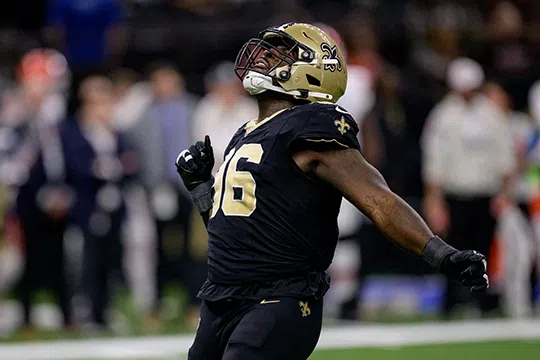By Ross Jackson
INDIANAPOLIS – Things are changing for the New Orleans Saints defense. While it won’t be a full sprint with defensive coordinator Brandon Staley in the building, expect the team to embrace new concepts and roles.
With the addition of new roles and responsibilities for the unit, the Saints should see expanding prototypes, as well.
Prototypes are always based on what works across the league. Which players are successful in their positions and what traits and qualities they have that create a reliable track record.
The prototype for a speed-to-power pass rusher is different from that of a speed rusher. The prototype of a nose tackle is different from that of a 3-tech pass rusher. So while the prototypes themselves don’t actually change often, added roles on any side of the ball still increase the number of those that are valuable to a team.
For New Orleans, additional roles on defense, such as standup pass rusher and nose tackle, will have that impact.
Starting with the edge rusher mold, let’s dive in on what things have looked like for the Saints, what could change, and which NFL draft prospects and free agents fit the bill.
The Previous Mold
When ex-head coach Dennis Allen was running the defense the focus off the edge was centered around big bodies and physical play styles. An emphasis was also placed on being an “edge defender” by trade, rather than an edge rusher purely. This meant an emphasis on stopping the run was just as important as the one to get after the quarterback.
Ends typically stand 6-foot-4 and above while weighing in at more than 260/270 pounds, sometimes into the 280 range. This consensus is so strong that defensive ends like Carl Granderson, who entered the league as an undrafted free agent at just over 250 pounds, have added significant weight as they developed.
The desire often centers around stout run defenders that could rush the passer through speed-to-power conversion. The kind of edge rusher who bullies opposing linemen into the quarterback’s lap rather than relying on speed to bend the arc and secure a sack within three seconds of the snap.
The balance of rush and coverage on the backend often results in sacks made on second and third efforts on the line as coverage holds up.
The Future of the Edge Defender
Think of what’s up next for New Orleans as less about changing roles and more about adding them. New Orleans will likely add a speed rusher build to their defense, but that won’t make the big-bodied defender obsolete by any means.
Even when using a three-man front with standup rushers added, the 3-4 ends are prototypically similar to the edge defender type. That means that players that fit the previously established criteria at the position still have an important role in the expected schematic additions.
Head coach Kellen Moore also alluded to the team still using its fair share of four down-linemen in nickel (five defensive backs) sets.
“I think at the end of day, you’re going to win the game and lose the game in nickel,” Moore said during the NFL Combine. “4-2-5.”
That also keeps the door open for the so-called NASCAR package which features three edge rushers and one interior defender. The bigger body types will have more success moving inside for those snaps.
The New Mold
Many have called the Saints’ defensive approach to pass rushing antiquated because of the lack of emphasis on speed. That is likely to change moving forward. In addition to the pass rushers that can take the snap out of a three-point stance and cause havoc across the line, New Orleans is likely to incorporate more standup pass rushers that win with speed and athleticism over size and strength.
In a 3-4 scheme, physical linemen at defensive end are often paired and bookended with speed-focused pass rushers at outside linebacker. The outside rushers are more often lined up in a two-point stance without their hand in the dirt, allowing them a quick start at the snap. Get-off time becomes a major part of their success or lack thereof.
The prototype of a speed rusher is smaller than that of the edge defender, but isn’t exclusive. The ideal measurements range from 6-foot-1 and above, while weight numbers usually track at or less than 260 pounds.
A 6-foot-5 and 260 pounds rusher could serve either of these roles. The deciding factor would simply be play style and natural ability. So, the measurements are far from the end-all-be-all.
Who Fits the New Role?
Several expected free agents and NFL draft prospects check the boxes for the new responsibilities, expanding the potential player pool from which additions can be made by the team this offseason. Here are some of the options:
Internal:
Saints Carl Granderson – 6-foot-4, 261 pounds
Free agents:
Chargers Khalil Mack – 6-foot-3, 269 pounds
Jets Haason Reddick – 6-foot-1, 240 pounds
Chiefs Joshua Uche – 6-foot-3, 240 pounds
Cardinals Baron Browning – 6-foot-3, 240 pounds
Giants Azeez Ojulari – 6-foot-3, 240 pounds
Draft prospects:
Georgia’s Jalon Walker – 6-foot-2, 245 pounds
Ole Miss’s Princely Umanmielen – 6-foot-4, 264 pounds
Boston College’s Donovan Ezeiruaku – 6-foot-2, 248 pounds
Center Arkansas’s David Walker – 6-foot, 267 pounds
UCLA’s Oluwafemi Oladejo – 6-foot-2, 261 pounds
Marshall’s Mike Green – 6-foot-3, 251 pounds





